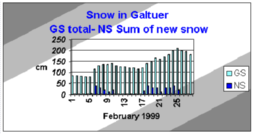Introduction
There was a long period during February 1999 where the Alpine region was affected by intense precipitation, mostly snowfall. Although the regions where the main snowfall intensity was observed changed throughout the whole period, two sub-periods can be selected where precipitation took place over the whole Alpine mountain range:
- 05 - 10 February
- 17 - 25 February
The consequence of this long and intensive snowfall were many catastrophic avalanche events in all the Alpine countries like France, Switzerland and Austria. For ZAMG, as author of this case study, the avalanche catastrophe in Galtuer (Tyrol) with more than 30 dead persons is documented best.
The graphics show the cumulative heights of new snow for Galtuer during February 1999 as well as the relationship between new and total snow. The periods with new snow correspond to the periods mentioned above. Cumulative heights of up to 400 cm are recorded. The table shows that these amounts are the highest observed during the last 100 years. The table shows, furthermore, that also for other villages in the Austrian Alpine area the snow heights were highest or the second highest since records began.
The main reason for the catastrophic avalanche events are not single weather situations and/or conceptual models but the persistance of weather situations (conceptual models) that are associated with winds having a normal component to the Alps and therefore creating Stau precipitation.
The case study is divided into an overview part where 3-hourly satellite images and precipitation reports are presented chronologically in the form of 12 phases, each comprising a different synoptic situation and/or development.
Then, the main synoptic processes that occurred in this period during these chronological phases are summarized and examinde in detail with the help of typical examples.


